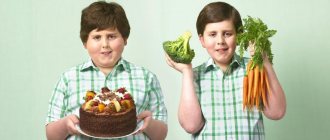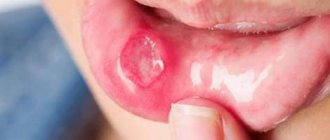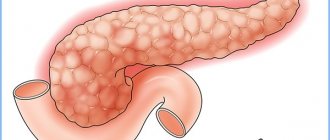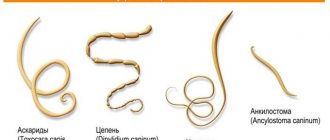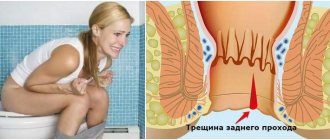The appearance of the first baby teeth in babies is a real event for the whole family. Previously, pediatricians set specific deadlines for teething to be considered normal. Today there is an approximate period in which teething symptoms in children fall.
As for the appearance of permanent teeth in older children, this process still has a time frame, beyond which it is considered a deviation from the norm. The entire process of “germination” should be monitored by a doctor.
Features of teething in children after one year
Teeth appear over a fairly long period of time and, of course, this is an individual process, but there are generalized time frames.
So, after a year, the upper and lower molars, canines, and second molars grow.
During teething, the child experiences discomfort and pain in the oral cavity.
This process may be accompanied by a number of general and local characteristic symptoms. You can determine that a child is teething by knowing the signs of this condition.
The body's reaction to the first teeth
At what months does a baby start teething?
For some reason, the science of medicine believes that the process of “cutting through” is rarely accompanied by a painful condition. But experienced medical practitioners, as well as no less experienced mothers, know exactly how a perfectly healthy child’s mood suddenly deteriorates, his appetite disappears, and a fever appears out of nowhere. After a few days, the tooth appears and the alarming symptoms disappear.
The thing is that such a natural process – the appearance of teeth – greatly increases the load on the immune system, and the body naturally reacts. The mucous membranes in the mouth and nose begin to actively produce large amounts of mucus: snot and saliva. In this case, the erupting tooth puts pressure on the gum, causing pain and inflammation. In this situation, the only thing left for the baby to do is to inform his parents about his problem in all ways available to him (crying and tears). The tooth may erupt within a few days or a week.
Parents, in turn, need to carefully study and understand the symptoms of teething in infants in advance.
General signs
- Behavior change. A child whose baby teeth are growing becomes restless and may become more moody or whiny. The process of teething is accompanied by a violent manifestation of character, sometimes aggression.
- Restless sleep. Suffering from the painful appearance of baby teeth, babies often wake up at night, sometimes sobbing and shuddering. Crying and lack of normal sleep are very common reactions to teething.
- Decreased appetite. Inflammation of the gums, pain while eating and anxiety can cause the child to lose his appetite.
- Changing taste preferences. Against the background of inflammatory processes in the gums and decreased immunity, the baby often cheats on his favorite dishes. This is also due to the fact that due to the inflammatory process, taste buds can be damaged and change the taste of food.
- Itching in the gums. Breaking through the tissues of the body, baby teeth give the child very unpleasant sensations. Itching appears, which intensifies against the background of growing inflammation. This itching is sometimes replaced by pain, at these moments children put everything in their mouths and try to bite something to scratch their gums.
The process of eruption of temporary teeth: order and timing
As soon as the baby grows 4 central incisors, the lateral incisors will begin to emerge. There are also four of them: a pair on each jaw. But unlike frontal ones, they first appear from above, and then from below. Typically, children under one year old acquire exactly 8 teeth. If this does not happen, you should consult a dentist.
When the reason for the delay is related to heredity or climate, which affects the rate of growth, there is no need to worry. But things could turn out to be much more serious. For example, there is such an anomaly - adentia , in which the rudiments of the teeth are partially laid down or are completely absent. Pathology is eliminated by installing prostheses.
Diagram: sequence of growth of baby teeth
When a child reaches one year of age, his first chewing molars and canines, which are needed for tearing hard foods, will begin to emerge. The primary row ends with the second molars. During the growth of fangs, the baby becomes very capricious, since their sharp tip injures the soft tissues. The process is accompanied by an increase in temperature, which can rise to 39 °C, profuse salivation and inflammation of the gums. These are the most painful teeth, so during the period of their growth, the mother must make every effort to alleviate the child’s condition.
Local signs
- Increased body temperature. Very often, the appearance of baby teeth is associated with inflammatory processes, a decrease in local immunity and, as a result, an increase in temperature. The presence of this symptom indicates the body’s resistance; it is it that forces the immune system to more actively fight inflammation and the possible development of infection. High temperature (38.5 °C - 39.5 °C) can last one to two days. If this symptom persists for a longer period of time, you should consult a doctor.
- Swelling of the gums and swelling at the site of eruption. Teething is a traumatic process for the gums. They swell, become brighter, and pronounced swelling is observed. These troubles are associated with soft tissue damage that occurs during a tooth breakout. Sometimes it can damage the capillaries, which leads to the appearance of a blue tint in the eruption area. A slight change in the color of the gums at the site of swelling is a completely normal condition that does not require any special worries. If the swelling, swelling and bruising become more pronounced and painful, you should immediately consult a specialist.
- Increased salivation. This symptom is a protective reaction of the body and a harbinger of the appearance of teeth. The appearance of excessive salivation is associated with irritation of the nerve endings of the gums. Also, in addition to increased salivation, the baby’s cheeks turn red. It is very important to maintain hygiene and constantly wipe your mouth of saliva. Otherwise, irritation appears around the mouth, which aggravates the child’s painful condition.
Uncharacteristic symptoms
The first tooth is an exciting event in the life of a family. Therefore, inexperienced parents lose sight of the fact that the condition of the milk supply must be carefully monitored. For any deviations, contact the dentist. What adults should be wary of:
- nonspecific color of enamel (yellow or brownish tint) indicates taking antibiotics during pregnancy;
- black spots indicate inflammation or excess iron in the blood;
- greenish-yellowish plaque is a manifestation of disturbances in bilirubin metabolism;
- malocclusion does not appear due to the pacifier in the oral cavity, but as a consequence of prolonged breastfeeding;
- Non-specific tooth position implies a genetic deviation, an individual characteristic or a tumor of the alveolar process of the jaw.
Any deviations, pathologies and doubts should be brought to the dental office. The appearance of plaque on the fangs and non-standard location should alert parents.
Cough
It just so happens in the medical field that pediatricians do not associate additional symptoms with the “season” of teething. This approach often turns out to be wrong. Jaw development takes several months. The body of children during this period is significantly weakened. This means that you can easily get an infection. Therefore, if you notice any changes in your health, call a doctor.
When a child is capricious, irritated and coughs, parents become worried. At the appointment, the doctor will examine the baby and decide whether to prescribe medication, or whether the cough reflex has triggered due to excessive salivation. Causes of cough:
- sputum;
- salivation;
- runny nose;
- colds.
Irritation and redness often appear on the baby's skin near the mouth. Komarovsky, an experienced doctor, says that the cough reflex is a natural way of cleansing the body.
Diarrhea (diarrhea)
The initial stage of growth is sometimes accompanied by diarrhea. This phenomenon is not a rare factor and can be explained. When a child’s first teeth “peck”, the child’s health deteriorates. The immune system perceives the released substances as invaders. The result is fever and cough. Diarrhea against this background causes panic in adults.
The symptoms when molars are cut in children coincide with the general symptoms; diarrhea during the development of a young jaw is repeated up to 3 times per day. In total, this symptom lasts from 3 to 4 days. As a rule, the factors of the disorder are:
- saliva, once in the gastrointestinal tract, dilutes the stool;
- stomach microbes lead to disorders in the digestive system;
- the appearance of new foods in the diet;
- change in the speed of the metabolic process;
- stress.
You should be wary if:
- diarrhea occurs more than 5 times in 24 hours;
- stool color with a greenish or black tint;
- diarrhea persists for more than 3 days;
- traces of blood or foreign inclusions are visible in the stool;
- watery diarrhea accompanied by pain.
These symptoms indicate an infection or virus. It is immediately necessary to show the baby to a pediatrician to determine the source of the infection.
Vomit
An intestinal infection is accompanied by nausea and vomiting. When faced with the phenomenon for the first time, parents do not think that the negative symptom that appears may be witnessing the appearance of incisors.
A face-to-face consultation with a local pediatrician will help determine the true culprit of this condition. During the physical examination, the attending physician will name the main causes of vomiting:
- irritation of the uvula with saliva;
- itching in the gums forces you to chew everything around (the result of this is an infection);
- problems with nutrition (increased milk consumption, refusal to eat), which leads to vomiting;
- accumulation of air in the stomach;
- fever;
- forced feeding.
When teeth begin to cut, this condition is similar to many diseases. A doctor can exclude such a development of events.
What temperature can occur during teething? Fever is one of the factors that is observed at the time of eruption of molars and incisors. Many reviews on forums and explanations from doctors confirm that at the time of the incision, a substance is released in the gum to soften the tissue.
This leads to the appearance of an inflammatory process. The immune system seeks to suppress symptoms, causing fever. Doctors believe that fever is a protective reaction. It does not require drug intervention. However, treatment is needed when the temperature rises to 38°C.
When considering such dubious symptoms, you must remember
- Most often, after a year, a child no longer receives breast milk. And if previously, thanks to breastfeeding, the baby received the necessary microflora, stabilized the immune system and eliminated infections, now the little body no longer receives maternal nutrition. This fact contributes to the fact that against the background of a decrease in local immunity, the body is exposed to a much greater risk of developing infections. They may cause additional controversial symptoms to appear.
- During the teething period, the baby's gums are very itchy. The child puts into his mouth everything that comes into his hands. Hence the appearance of concomitant intestinal infections.
- Pathogenic microorganisms constantly surround the child, and during teething they can easily develop due to weakened immunity. For this reason, a cough, runny nose and temperature over 38 °C may appear. Young parents often miss the moment when the described symptoms occur and attribute them to the appearance of teeth. But teething only slightly weakens local immunity and cannot cause the development of a cough or runny nose.
- There is only one type of runny nose, which is characteristic of the teething process. Discharge from the nose is similar to water and does not cause any discomfort to the child. If any inclusions or changes appear, it means that an infection has occurred and a runny nose requires treatment.
A temperature above 38.5 °C that lasts for more than two days is a reason to immediately contact a specialist. A neglected inflammatory process can lead to serious illnesses.
Timing of teething
The laying of teeth occurs even before birth. Already in the sixth week of embryonic development, the embryo begins to develop the rudiments of temporary teeth. And at the 5th month of pregnancy, the fetus begins to develop permanent teeth. They make their way out from the moment of laying until complete eruption.
It is interesting to know that some children may erupt teeth in the womb, and they may be born with lower incisors. And for some babies, teething may be significantly delayed. Today this is not considered a serious problem.
According to average indicators, teeth erupt in the following order:
- Lower incisors - from 6 to 9 months.
- Upper incisors - 7–10 months.
- The upper lateral incisors are about a year old.
- Lower second incisors - in the same period.
- The first upper molars - from a year to a year and a half.
- The first lower molars appear almost immediately after the upper ones.
- The upper canines appear between one and two years of age.
- The lower canines are a couple of months later.
- The second molars of the lower teeth erupt by the age of two years.
- Second upper molars - 2–3 months after the lower molars.
These dates are very approximate; in fact, teeth may not appear according to this schedule. Read more about the teething pattern in babies →
How to help a child after a year during the period of teething
- The easiest way is a teether. A toy made of silicone and filled with water. The surface of the teether is non-uniform. It may have teeth, pimples, and protrusions of various shapes. All this is done so that the baby can scratch all his gums with a cooled toy. Before use, the massager is placed in the freezer.
- In order to massage the gums a little and scratch them, parents can use a special attachment on their finger in the form of a toothbrush.
- If a high temperature occurs and to relieve pain, you can give your child Ibuprofen for children or Paracetamol, also in a pediatric dosage.
- There are a number of homeopathic remedies available to reduce the appearance of teething symptoms. Such drugs include, for example, Dentokind. According to many mothers, the pills really help.
- Pain-relieving gels are anesthetics. These are special local gum gels with a pronounced analgesic effect. The gel is applied to the gum with swelling, and it is frozen for a short time.
- You can relieve inflammation and alleviate the baby’s condition with chamomile decoction, weak tea, soda solution or Miramistin. Chamomile has anti-inflammatory and mild sedative properties. Due to its tannin content, tea promotes gum healing. Soda relieves inflammation, and Miramistin fights not only infections, but also viruses that can cause serious illnesses.
Changing the stool
Symptoms of eye teething in children may manifest as changes in the functioning of the gastrointestinal tract. Since babies at this moment prefer to consume liquid food (usually mother’s milk or formula), a slight dilution of the stool occurs. Remember not to confuse obvious diarrhea with this sign of teething. If a child starts vomiting and has a fever, this is a clear symptom of an intestinal infection.
Liquefied stools during teething occur no more than three times a day. At the same time, the baby is not bothered by abdominal pain and fever.
Important signals to see a doctor immediately
- A sharp rise in temperature above 38 °C, which lasts more than two days.
- The appearance of accompanying symptoms: cough, runny nose, nausea, weak stomach, vomiting.
- The occurrence of cramps and numbness of the limbs.
The period of appearance of baby teeth is very hectic for both the child and his parents..
Often, poor sleep, lack of food, and constant discomfort do not allow the baby to relax. At such moments, children need special care and attention in order to prevent the development of serious diseases due to teething.
Formation of the human dentition.
Normally, an adult has 28-32 teeth. However, they do not appear at once, but in several stages up to 14 years. The “era” of mixed dentition is ending, the beginning of which is marked by the loss of baby teeth in the fifth or sixth year of life.
After 3-4 months, new ones grow in their place. At the same time, 8-12 initially permanent teeth (molars and chewing teeth) grow.
Complete renewal of the dentition takes several years. As a result, baby teeth are replaced by new ones, which remain for life.
“Permanent residents” replace the teenager’s children’s “milk twenty.” This is the first set of teeth: incisors and molars in the amount of 4 pieces on top and bottom, plus a pair of fangs on the upper and lower jaws.
Note: Premolars will grow later and will assist the biting canines and chewing molars.
- The order and features of the appearance of teeth
It is especially important to know what symptoms occur when a child is teething, during the period of primary occlusion. The first tooth can begin to hatch as early as 4-5 months.
External manifestations of the body’s preparation are noticeable even 4-8 weeks before this event. At this age, children do not yet express in words the reasons for their anxiety.
Knowing which teething symptoms appear first in babies and noticing them in time, you can prepare and properly help your child.
When and in what order are they cut?
Chewing teeth begin to grow in babies after a year, when the first 8 teeth - incisors - are already in place . They do not appear in a row: after the first molars (their number in the dental formula is 4), fangs (3) usually grow, and only then do the second molars (5).
The dental formula shows which teeth the child has already grown, designating each by its number from the center of the jaw.
Table: sequence and timing of eruption of first and second primary molars
It is important to remember that any sequence of eruption of baby teeth, as well as the timing of their appearance, deviating from the generally accepted ones by no more than six months, is an individual variant of the norm.
Video: timing and order of teeth appearance
Permanent molars in children begin to erupt around the age of six . First, the first molars (6) grow, then a pair of premolars (4, 5), canines (3) and only after the canines - the second molars (7).
Table: sequence and timing of eruption of permanent premolars and molars
The order in which permanent teeth erupt is also very arbitrary. By about 13 years of age, a child has 28 permanent teeth.
How to relieve your baby's condition with medications
If your baby is bothered by sore gums and begins to behave restlessly, you can give him a mild pain reliever that is appropriate for his age. For the youngest, it is better to use candles, and older children can be given a special suspension. These drugs, in addition to a sedative effect, have mild antipyretic properties.
In addition, pharmacies sell a special anesthetic gel, a small amount of which should be applied to the surface of the inflamed gum. However, you should not get carried away with such gels, since most of them promote increased salivation and also cause numbness, which makes the baby feel uncomfortable.
Important:
Before purchasing one or another medication to alleviate a child’s teething condition, you should definitely consult a pediatrician to rule out side effects.
Rules of care
Experts give the following general recommendations for caring for teething teeth:
- Visit your dentist, let him give you all the necessary advice and select safe medications to relieve fever, pain and inflammation.
- Never lick your baby's pacifier or pacifier! For an older child, provide separate cutlery—a spoon and a fork—that only he or she will use.
- Follow the rules of daily oral hygiene for your child. It is recommended to brush the teeth of children over 1 year old with special soft children's brushes. When the child gets older, it is necessary to teach him the correct movements so that after the procedure the lumpy surface of the chewing teeth is truly clean.
- Teach your child to rinse his mouth with water every time after eating. If food gets stuck between your back teeth and/or gums, use dental floss to gently clean the area.
- Give your child water more often to avoid dry mouth.
- Try to limit your consumption of foods containing sugar.
- For teeth to grow strong, food must be nutritious and varied.
Read also: What kind of molars do children have?
Children usually tolerate the eruption of premolars and molars easily, but parents need to control this process. After all, primary chewing teeth play an important role in the development of independent eating skills, and the permanent teeth that replace them determine the correct formation of the bite. Temporary back teeth should in no case interfere with the growth of permanent ones, so in some cases their timely removal may be necessary.
Types of chewing teeth
There are only 8 primary chewing teeth, 4 on each jaw, 2 on each side . Officially, the pair of back teeth is called the first and second molars. Compared to permanent teeth, they are smaller and also have thinner enamel, increased fragility and a greater risk of damage.
Read also: Do 5 teeth change in children?
Scheme of baby teeth eruption
After the growth of the baby tooth is completed, a period of physiological rest begins, lasting about three years. Then the roots begin to shorten, dissolve, and the tooth becomes mobile and falls out. A permanent one grows in its place.
The permanent chewing teeth are called premolars and molars. Counting from the middle of the jaw, premolars are the fourth and fifth, and molars are the sixth, seventh and eighth .
Chewing teeth are called molars because of their shape. Premolars are also called small molars. First and second molars differ in root structure and crown shape. The sixth and seventh teeth of the upper jaw each have three roots, a cuboid crown and 3–4 cusps. The lower molars have 2 roots. In this case, the second molar is smaller than the first.
In total, each person has 8 premolars and 8 molars. Permanent teeth, which are the eighth in a row - wisdom teeth - do not erupt in all people. As a rule, the total number of teeth is 28 (of which 16 are chewing).
How can I help my child?
Parents must have tools in their arsenal that can help their child get through the difficult time until all the teeth come out. In addition to special teethers, which can be pre-cooled, a number of medications are used. There are also time-tested folk remedies for reducing pain during teething. Let's look at them in the following sections.
READ ALSO: Can a child get a DPT vaccine when teething?
Medicines
Medicines that will help reduce the manifestation of painful symptoms in a child can be divided into three groups. These are painkillers, topical medications and homeopathy. Parents should choose those to which the child responds well, and be sure to follow the recommended dosage.
| Group of drugs | Indications | Drug names | Notes |
| Painkillers and anti-inflammatory | With fever and severe pain. You can give it if the baby is crying, his gums are swollen, or swelling appears. | Nurofen, Ibuprofen, Paracetamol, Efferalgan, Panadol | These medications should not be given for more than three days. It is advisable to maintain an eight-hour interval between doses. Best given at night to promote sound sleep. |
| Products with a local effect (gels, ointments for application to the oral mucosa) | Redness and swelling of the gums, pain. | Holisal, Baby-doctor, Kamistad, Dentol-baby, Solcoseryl, Pansoral | Apply to swollen gums several times a day after feeding. For pain, it is better to use drugs with an anesthetic (Cholisal, Kamistad with lidocaine). |
| Homeopathy | It is recommended to use throughout the entire dental period, since these products have accumulative properties. The downside is that their effectiveness has not been proven. | Dentokind tablets, Viburkol suppositories | The tablet is given after dissolving it in a teaspoon of water. It is allowed to give the baby up to 6 pieces per day during the acute period and 3 after the condition improves. |
Some practicing pediatricians recommend giving your child antihistamines if the gums are swollen. Fenistil, Zodak, Zyrtec relieve swelling and greatly facilitate nasal breathing.
Folk remedies
Our grandmothers knew the secret of how to help a baby cope with the pain that occurs during teething without the use of medications. Today folk remedies are also popular. Among the simplest are the following:
- A piece of ice wrapped in a clean cloth. Wipe the gums with light movements, without lingering in one place, so as not to catch the baby’s cold. The procedure should take no more than 2 minutes.
- In the same way, you can wipe your gums with a cooled terry towel or simply let your baby chew it.
- Some parents use honey. This product should be lubricated on the gums from time to time. Remember - honey is a strong allergen and is not recommended for children under one year of age.
- Wipe your gums with a soda solution. It is prepared at the rate of 1 tsp. soda per glass of water.
- You can rub an infusion of valerian into your gums. However, for this purpose, do not use a pharmacy alcohol tincture, but use herbs brewed with boiling water.
Next, we will consider more complex methods of alleviating the child’s condition:
- Chamomile tea. Brew chamomile flowers (2 tablespoons of dry raw materials per glass of boiling water), let it brew. Lubricate the gums with the infusion and at the same time give the baby 1 teaspoon to drink three times a day.
- Prepare a tincture of burdock root. Rub into gums several times a day.
- Clove oil has pronounced analgesic and anti-inflammatory properties. Before using it for babies, you should dilute the product with olive oil in a 1:1 ratio.
Share with friends!
When, at what months, do babies cut their first teeth?
Factors that negatively affect tooth formation:
- maternal pathologies;
- toxicosis in the last trimester of pregnancy;
- nervous and allergic diseases;
- metabolic disease;
- bad habits of the mother (smoking, drinking alcohol and drugs);
- genetic predisposition;
- infection of the child with various infections in the prenatal period;
- ecology.
The baby's first pair of incisors appears at six months. Teeth cutting through the gums between 4 and 9 months of age is normal and should not worry parents. First, the lower central incisors erupt, then the upper ones. At about 9 months, the baby's molars appear. After a year, fangs begin to grow. By the age of 3, the process of formation of the masticatory apparatus ends. The exact diagram indicating age is shown in the photo.
If teeth begin to grow after 3 months, this is considered normal. Rapid formation occurs due to the mother taking vitamin complexes during pregnancy or consuming large amounts of fermented milk products. If the first teeth are cut before 3 months, this may indicate hormonal imbalances.
The teeth come out in pairs. If teeth grow in a different order, you should consult your pediatrician or dentist. It is worth noting that each child is individual, and the teething process for some babies may be delayed or go much faster than their peers. Parents need to be patient and surround their baby with attention and care during this difficult period for him.
The rudiments of teeth are formed in the prenatal period; they are located deep in the alveolar processes. The process of teething is an increase in the volume of teeth and their pushing out. You can notice the first symptoms of teething long before they appear, because... their growth begins to bother the baby when the processes first move outward.
As a rule, at this time children become capricious, their sleep and appetite are disturbed. Breastfed babies begin to ask for breastfeeding more often in order to alleviate their condition. Some, on the contrary, refuse to eat. Sleep problems are also associated with pain that occurs at night. The child takes a long time to fall asleep, often wakes up and cries.
From doctors of the “old school” you can hear that the first teeth erupt in a baby at the age of 6 months. Modern pediatricians set the range from 4 to 8 months. The famous doctor Komarovsky generally claims that it is unfair to set any deadlines: one in 2000 babies is born with 1-2 teeth, one in 2000 does not have them until 15-16 months. Everything here is individual, since many factors influence when the baby’s first tooth starts chattering:
- Genetics. If the baby's mom and dad started teething at 3-4 months, the baby will probably be early too. Conversely, you shouldn’t worry that a nine-month-old baby still has a toothless smile if his parents had the same thing at that age.
- Features of the course of pregnancy. Pregnancy with pathologies delays the timing of teething.
- Features of the course and date of birth. If your baby is born prematurely, his teeth may begin to emerge later. In this case, the biological age of the baby should be taken into account, and not his age according to the certificate.
- Illnesses in the child (due to some infectious diseases suffered by the child, teeth may appear later), the sufficiency of his nutrition, climatic conditions, living conditions, etc.
The order and timing of teething in a child.
It is already obvious that teething in infants can be early, that is, one that occurs before six months (at 2, 3, 4 months). But this does not mean that you need to get into your child’s mouth if, in your opinion, he is acting for no reason:
- gets restless
- doesn't sleep well
- refuses food
- constantly puts toys and rattles in his mouth
- temperature
- coughs or shows other warning signs
Show your child to the doctor; first of all, it is necessary to rule out diseases, and then start sinning on early teeth.
A child of 2, 3, 4 months may have his first tooth.
The order of teething can be as individual as the timing. But in most children it still persists. Study the table in the figure to understand which teeth are cut first, which ones and when to wait after them.
The sequence of teething in a child.
A child who has just been born has 20 follicles of temporary teeth in his gums. Before they “knock”, they pass through the bone tissue and gums. This requires a certain amount of time, strictly individual for each baby. Typically, the process of teething for a baby takes from 1 to 8 weeks.
Pulpitis of a baby tooth
Pulpitis is a common pathology among children. It develops due to the fact that the hard tissues (enamel and dentin) of baby teeth are very thin, so caries quickly “corrodes” them and quickly gets into the tooth pulp.
This disease is a complication after caries or injury. As a result of pulpitis, a purulent process in soft tissues can quickly develop, a fistula may appear on the gum, and the periosteum may become inflamed.
Previously, such teeth were removed, but today there are a number of procedures to cure and preserve them:
- Conservative treatment is used in the early stages of the disease. The carious cavity is opened (drilled out) and treated with antiseptics, then a medicinal paste is placed into it and filled. This therapy is often combined with electrophoresis. In total, the result of treatment is the disappearance of inflammation and preservation of the tooth.
- Surgical treatment (used in advanced stages). Involves partial or complete removal of the pulp, sanitation of dental tissues, filling of canals and teeth.
Is there any way to relieve the symptoms of teething?
If your child behaves very restlessly, then you should use some tips. All your actions should be aimed at alleviating the baby’s condition.
- Don't swear or shout. Be patient. It is much more difficult for the child now than for you.
- Use different medications as needed. Remember that many children's antipyretic drugs are also pain relievers. You should not get carried away with such treatment. Do not use the same product for more than five days.
- Massage your child's gums. Remember that your hands must be sterilely clean and your nails neatly cut. Now you can buy special finger brushes in pharmacy chains. They are made of high-quality silicone and do not have a harmful effect on the structure of the mucous membrane.
- Give your baby a teether. This accessory can be purchased at any children's store. Remember that it must be thoroughly disinfected before use.
- Offer your child a bagel. If the baby is already eating complementary foods or adult food, then you can give him a bagel or cracker. During the meal, he will be able to massage his itchy gums and feel relief.
- Wash your baby's hands regularly. To avoid infection and deterioration of the baby’s well-being, you should wash his palms as often as possible. A teething baby's fingers are in his mouth all the time.
- Wipe your face with a napkin. Due to excessive drooling on the chin and neck area, the baby may develop a rash. This is another sign of teething. This is all due to the fact that drool secreted irritates the delicate skin of the face. If you regularly wipe the area with a cleansing wipe, you can avoid this symptom.
Violation of deadlines
The timing of teething is a fairly dynamic indicator; it can be influenced by many external and internal factors. The timing of eruption can be significantly influenced by:
- the course of pregnancy, the presence of early and late toxicosis in the mother, violation of her physical condition, threats of termination of pregnancy, taking medications, diet, sufficiency of microelements,
- difficult birth, complications,
- prematurity, all premature babies develop teeth later,
- height and weight at birth, health status, season of birth. Winter children have a later period of teething due to a lack of sun in the first months of life and a greater likelihood of rickets.
- the presence of chronic diseases and nutritional disorders that impair the absorption of minerals.
- the presence of rickets or rickets-like diseases.
The timing of teething may be ahead of the average age. Usually heredity and a warmer climate play a large role in this, although in some cases these changes may be a reason to examine the child for endocrine pathology and accelerated maturation.
Precautionary measures
If any alarming symptoms appear (blue gums during teething, severe hemorrhage, increased bleeding), you should contact a pediatric dentist. Sometimes a dissection of the mucosa is required to allow tooth growth.
Under no circumstances should you independently dissect or even massage the area of hemorrhage, especially if the hematoma on the gum during teething is observed over a large area and there is pronounced swelling of the surrounding tissues.
To avoid infectious complications, you need to regularly boil in a soda solution or wash all objects that the baby puts in his mouth (pacifiers, teethers, toys).
If you notice symptoms of infection, you should urgently seek advice from a specialist. During this period, children experience a persistent decrease in local and general immunity, and improper treatment of infectious complications or lack of treatment can lead to dangerous complications.
Author: Olga Sazonova, doctor, especially for Mama66.ru
Medicinal methods to combat teething symptoms
Of course, most measures turn out to be ineffective, so when teething in children, medications are one of the highly effective aids. Pharmaceuticals offer many specialized gels, ointments and other topical products. Let us consider among them the most widely used in pediatrics and those that have stood the test of time. Many of the drugs listed contain lidocaine, which should be used with caution in pediatrics.
Dentinox(160-200 rubles) - gel or drops based on lidocaine and chamomile, has an anesthetic property. Use no more than 3 times a day; allergic reactions are possible. |
Baby Doctor first teeth(140-170 rubles) – hypoallergenic gel of plant origin, has a weak analgesic effect, and has a targeted anti-inflammatory effect. The product is absolutely safe to use for infants, which is a definite plus. |
Holisal(220-300 rub.) – the gel consists of choline salicylate components (anti-inflammatory effect) and an adhesive base, which helps the medicinal properties of the gel to act more effectively. Can be used up to 2-3 times a day. |
Kalgel(220-300 rubles) a product based on lidocaine, has a weaker analgesic effect, tastes sweet, which threatens the occurrence of an allergic reaction. The gel is used from 5 months to 6 times a day with an interval between doses of 20-30 minutes. |
Solcoseryl(about 200 rubles) – an adhesive-based gel, effective for open wounds on the gums. |
Homeopathy – Dantinorm babyThis is a homeopathic remedy, the components of which affect the symptoms of teething in babies in combination:
Unlike gels, this solution is applied internally and has a longer lasting effect. |
As for the use of such a product as Kamistad, which is now available in Russian pharmacies, it is contraindicated for children under 12 years of age; previously there was Kamistad Baby, the composition of which is safe for babies and could be used by children from 3 months. So Kamistad gel cannot be used in infants.
The use of any medicine to relieve painful sensations during teething requires consultation with a specialist, familiarization with and strict adherence to the instructions. You should take into account the influence of many factors, as well as the individual characteristics of your little one’s body.
What kind of teeth come in at 2 years old?
Chief physician, Dentist surgeon, implantologist,
Article checked by doctor
Few parents can boast that their children’s teeth grew without problems. This is usually accompanied by the child being particularly nervous; he cries a lot and may refuse to eat or sleep. Many children have a fever, and moms and dads are understandably afraid of the “teething” condition. But not only infants suffer from severe teething; teething can also cause some inconvenience for older children.
What kind of teeth come in at 2 years old?
Symptoms of the teething process
It is difficult to say exactly at what age babies will have their first teeth. This process is directly related to hereditary predisposition, individual characteristics of the development and life of the baby. But the moment when they begin to erupt can be determined by symptomatic signs.
- The appearance of signs of swelling, redness and swelling of the gums.
- Increased salivation process.
- The appearance of itching, which causes the child to have a urge to bite, gnaw on toys, or constantly keep something in the mouth.
- Decreased appetite, and in rare cases its complete loss.
- The appearance of the urge to vomit.
- Irritable, restless and tearful mood.
- Appearance of fever.
- Sleep is light and restless.
- The appearance of loose stools or, conversely, constipation.
When the first teeth appear, the baby becomes restless
This is how the body reacts to teething. The natural process occurs with a violent reaction affecting all family members.
How second molars are cut in two-year-old children
Chewing teeth are located further than the incisors and canines; it is correct to call them premolars and molars. The popular name for these dental units is molars or back teeth. It cannot be said that chewing teeth erupt without problems. For some children, the eruption of molars is at least uncomfortable.
When the second molars erupt, the following symptoms may be observed:
- sleep problems. It is difficult for the child to fall asleep during the day, he often wakes up at night;
- a general expression of anxiety. The baby is irritable, capricious, whiny;
The child is usually irritable and whiny
The child may cough
In rare cases, the baby may even develop allergies or diathesis. In any case, all the signs indicate that the baby is going through a difficult period - he is in pain, uncomfortable, scared. He suffers, but is not always able to convey to his parents the reason for his concern. It is imperative to help the child ease this difficult period.
Is it possible to go for a walk while teething?
It is possible and necessary to walk with a teething child. Fresh air and activity will only benefit him. But places with large crowds of people, where there is a high probability of contracting an infection, are best avoided during this period.
It is possible and necessary to walk with a teething child.



